Historian Paul Kennedy has called the emergence of the U.S. as player on world stage the most decisive change in late 19th century. America saw herself with a “special moral endowment” and felt justified in projecting influence beyond her borders. Americans still intended to avoid “entangling alliances” but felt free to get more actively involved in the affairs of the world.
Before 1865 America had been preoccupied with the Civil War, and while the nation was thus occupied, the European powers felt free to ignore the Monroe Doctrine. Spain attempted to reverse the course of a revolution in the Dominican Republic. Although the United States was unable to assist the rebels, Spain withdrew in 1865. The United States was also aware of disturbances in Mexico but did not intervene. The European powers had been involved with Mexico because of debts owed to them, and although Spain and Great Britain eventually withdrew, France stayed on.
Napoleon III, having declared himself the French Emperor and striving to emulate the deeds of his famous uncle, Napoleon I, named Archduke Maximilian of Austria to be the Emperor of Mexico. With the United States Army no longer involved in the Civil War, General Philip Sheridan was sent with 50,000 troops to the Mexican border in 1866. Issued an ultimatum, Napoleon finally pulled out of Mexico in 1867 and Emperor Maximilian was deposed and shot by a firing squad. The event was seen as a victory for the Monroe Doctrine. (Napoleon’s Mexican venture was the most serious challenge to the Monroe Doctrine until Soviet Premier Khrushchev introduced nuclear missiles into Castro’s Cuba in 1962.)
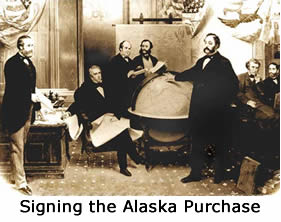 Russia, meanwhile, owned the territory of Alaska and in fact had ventured down the western coast of North America as far as Northern California, where they built Fort Ross, whose remains till stand. Anticipating, however, that holding on to a distant territory on a different continent might be difficult and unprofitable, the Russians were in the mood to get rid of the territory and sent a German negotiator to meet with the United States. Secretary of State William Seward purchased Alaska for $7.2 million, a venture which critics referred to as “Seward’s Icebox.” Given the vast natural resources of precious minerals and oil that were eventually discovered in Alaska, “Seward's Folly” turned out to be an excellent bargain.
Russia, meanwhile, owned the territory of Alaska and in fact had ventured down the western coast of North America as far as Northern California, where they built Fort Ross, whose remains till stand. Anticipating, however, that holding on to a distant territory on a different continent might be difficult and unprofitable, the Russians were in the mood to get rid of the territory and sent a German negotiator to meet with the United States. Secretary of State William Seward purchased Alaska for $7.2 million, a venture which critics referred to as “Seward’s Icebox.” Given the vast natural resources of precious minerals and oil that were eventually discovered in Alaska, “Seward's Folly” turned out to be an excellent bargain.
The busy secretary also negotiated a treaty to purchase the Virgin Islands from Denmark for $7.6 million, but the Senate refused to ratify the agreement. Meanwhile the United States occupied Midway Island in the Pacific.
In 1870 President Grant attempted to annex the Dominican Republic and sent agents to negotiate an agreement. Secretary of State Hamilton Fish, Grant’s most effective cabinet officer, was not particularly enthusiastic about the idea, and most of Grant's Cabinet disapproved. Yet, the president was undeterred. Grant lobbied the Senate heavily to adopt the treaty, but the Senate refused, leaving Grant frustrated.
Despite Grant’s interest in foreign affairs, Americans kept busy expanding internally. With the frontier to conquer and virtually unlimited resources, they had little reason to look elsewhere. Americans generally had a high level of disdain for Europe, although wealthy Americans were often educated there and respected European cultural achievements in art, music and literature. Americans also felt secure from external threat because of their geographic isolation between two oceans, which gave them a sense of invulnerability. Until very late in the 19th century Americans remained essentially indifferent to foreign policy and world affairs.
What interests America did have overseas were generally focused in the Pacific and the Caribbean, where trade, transportation and communication issues commanded attention. To the extent that Americans wanted to extend their influence overseas they had two primary goals: pursue favorable trade agreements and alignments and foster the spread of Christian and democratic ideals as they understood them.
America had always been driven by the idea of “manifest destiny,” which was at first the idea that the U.S. was to expand over the whole continent of North America, “from the Isthmus of Panama to the Arctic Circle.” While Canada and Mexico seemed impervious to further expansion by Americans, at least there had been the rest of the mainland to fill up. With the ending of the frontier and the completion of the settlement of the West, however, the impulse for further expansion spilled out over America’s borders. American isolationism began to change late in the century for a variety of reasons.
First, the industrial revolution had created challenges that required a broad reassessment of economic policies and conduct. The production of greater quantities of goods, the need for additional sources of raw materials and greater markets—in general the expansive nature of capitalism—all called for American to look outward. Following the purchase of Alaska, the United States began to develop commercial interests in the Caribbean and the Pacific in places like Cuba, Hawaii, Midway, Samoa, and the Virgin Islands.
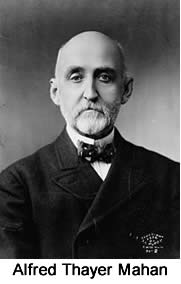 Mahan and Sea Power. A great part of the impetus for expansion came from a rather unlikely source, naval officer Captain Alfred Thayer Mahan. Founder of the Naval War College, Captain Mahan began to write books and articles that called for America to develop its strength on the basis of sea power, which he found to have been a decisive force throughout history in making nations and empires great and long lasting. (See Alfred Thayer Mahan. The Influence of Sea Power Upon History 1660-1783, Cambridge, MA, 1890. Mahan wrote ten other books on the same theme as well as articles in magazines such as The Atlantic Monthly.)
Mahan and Sea Power. A great part of the impetus for expansion came from a rather unlikely source, naval officer Captain Alfred Thayer Mahan. Founder of the Naval War College, Captain Mahan began to write books and articles that called for America to develop its strength on the basis of sea power, which he found to have been a decisive force throughout history in making nations and empires great and long lasting. (See Alfred Thayer Mahan. The Influence of Sea Power Upon History 1660-1783, Cambridge, MA, 1890. Mahan wrote ten other books on the same theme as well as articles in magazines such as The Atlantic Monthly.)
Mahan’s theme was the “Influence of Sea Power Upon History.” His basic idea was that to remain great and strong in an ever more competitive world, America needed a powerful maritime force, both naval and commercial. It also needed an overseas infrastructure of bases, coaling stations and the like to support a powerful fleet in the age of iron and steam. Mahan did not confine his thoughts strictly to naval matters. He also brought in ideas relating to the expansion of commercial interests and overseas markets for American goods, developed under the aegis of naval might. His work was widely read and applauded, not only by men like Theodore Roosevelt, but also by leaders in Great Britain and Germany. One result was a naval arms race that heightened tensions among the European powers.
Mahan’s ideas, which were compatible with the popularized notions of social Darwinism (maritime nations were among the fittest and therefore could and should survive), were not the only ideas that propelled Americans’ thoughts beyond her borders. The missionary spirit was still strong in America, and many felt that the spreading of Christianity went nicely with the concept of spreading democracy. Inherent in this view was a clearly racist streak of thought which maintained that the European races, particularly the Anglo-Saxon race, were inherently superior; they had the right, if not the obligation, to spread their beneficial influence all over the world to less fortunate peoples.
Furthermore, even if Americans had reservations about those expansionist ideas, as many did, their doubts were often tempered by the fact that everybody seemed to be doing it. This was the age of so-called neo-imperialism, when the European powers seemed bent on gobbling up all the underdeveloped areas of the world and turning them into colonies for military, commercial or political purposes.
A final piece of this newly evolving American foreign policy was a renewed confidence in the essential idea of the Monroe Doctrine—that the United States was the gate keeper and protector of the Western Hemisphere. What would eventually become the Roosevelt Corollary was established by 1900—that we had the final say in controlling all the territory from the Atlantic to the Pacific Coast in North and South America.

The Alabama Claims. During the Civil War a number of British-built Confederate raiders, the C.S.S. Alabama, C.S.S Shenandoah and others, had destroyed 100,000 tons of United States shipping. In 1869 Secretary Seward negotiated an agreement to adjudicate American claims against Great Britain, but the agreement was rejected by the Senate with a vote of 53 to 1. Secretary of State Hamilton Fish reopened the issue, and the Treaty of Washington of 1871 led to an agreement to submit the claims to an international tribunal consisting of Italy, Switzerland, Brazil, Great Britain and the United States. The tribunal eventually awarded the United States $15.5 million in damages, noting that Great Britain had failed to exercise “due diligence” in allowing British shipbuilders to violate neutrality policies. The peaceful settlement of the claims was deemed the outstanding accomplishment of the Grant administration.

Foreign Ventures and Misadventures. The building of the transcontinental railroads had brought many Chinese laborers to the United States, and they did not easily assimilate into American culture once their building duties were done. In 1885 Chinese settlers were massacred in Wyoming, and anti-Chinese agitation was widespread on the West Coast. Many Chinese returned to their native land and spread stories about their mistreatment at the hands of the Americans. In 1882 Congress passed the Chinese Exclusion Act, which restricted Chinese immigration for 10 years. Tense relations between the United States and China persisted into the 1900s.
Additional incidents regarding the United States and the rest of the world flared up from time to time. Despite tensions among the United States, Germany and Great Britain, America became part of a joint protectorate over Samoa and eventually became the owner of American Samoa in 1929. (In March, 1889, a typhoon destroyed several American and German ships in the Samoan Islands, possibly averting a shooting war.) Trouble arose briefly in New Orleans over the killing of several Italian citizens connected with the Mafia. Although the Italians were angered, United States maintained the position that it was a matter of Louisiana state law. A dispute in Chile once again saw gunrunners interfering in a Civil War. When the U.S.S. Baltimore visited Chile, two American sailors were killed and 17 wounded in a mêlée. Chile eventually indemnified the United States for the sailors killed.
In 1895 a dispute arose over the border between Venezuela and British Guiana. The United States offered to mediate the dispute, but the British rejected the idea. The British decision irritated United States Secretary of State Richard Olney, who declared that the United States was “practically sovereign” in the Western Hemisphere. Great Britain answered that the Monroe Doctrine had no force in international law, but decided it was in her own best interest not to pursue the matter, feeling that “war would be an absurdity.” (Besides, Great Britain was having trouble with the Boers in South Africa.)
Cuba. The United States had had an eye on Cuba since before the Civil War, and in 1868 an insurrection known as the Ten Years War broke out on the island. The Cubans declared their independence and set up a provisional government, but its status was uncertain when President Grant took office. A United States mediation plan was unsuccessful, and Secretary of State Fish worked to keep the United States from intervening.
In 1873 trouble erupted again when American gunrunners were caught providing aid to the Cuban rebels. The Spanish government captured a vessel, the U.S.S. Virginius, and executed the crew, including Americans. Just before he was hanged, the ship's commander, a Captain Fry, sent a pathetic letter to his wife which was published in a New York newspaper. War fever flared up in the country, and coastal cities armed themselves, but Secretary Fish was once again able to resolve the issue peacefully. Spain later paid an indemnity to the families of the executed Americans. Although the bloodshed continued in Cuba for several more years, Spain finally enforced peace, but future troubles between the United States and Spain over Cuba remained a distinct possibility.
The Spanish-American War
Not surprisingly, trouble flared up again in Cuba in 1895. Spain dispatched 50,000 troops to the islands, and a Spanish gunboat fired on a United States steamer. American businesses had invested heavily in mining and sugar operations in Cuba, and the panic of 1893 had left investors edgy. For a variety of reasons Americans were predisposed to assist the Cuban rebels in their struggle for independence. The United States had gone 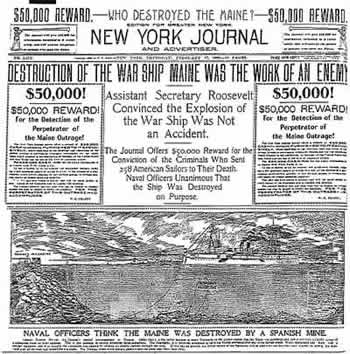 through a similar struggle with Great Britain a century earlier. The revolutionists also carried out an effective propaganda campaign, which included destruction of American sugar mills and railroads, designed to bring about American intervention in the revolt. The Cuban rebels determined, not unreasonably, that if America became involved in dispute, it would likely be on the side of the Cubans seeking independence. The propaganda campaign was also carried on in New York City under the guidance of rebel leader José Martí.
through a similar struggle with Great Britain a century earlier. The revolutionists also carried out an effective propaganda campaign, which included destruction of American sugar mills and railroads, designed to bring about American intervention in the revolt. The Cuban rebels determined, not unreasonably, that if America became involved in dispute, it would likely be on the side of the Cubans seeking independence. The propaganda campaign was also carried on in New York City under the guidance of rebel leader José Martí.
With the war going badly, in 1896 Spain sent General Valeriano Weyler to Cuba. Weyler soon established concentration camps to hold captured rebels in addition to other hard-nosed policies. During the presidential election of that year, the Republican Party had adopted an expansionist platform, which helped get William McKinley elected. The existence of the Weyler policy of reconcentrado, which led to his being known as “Butcher Weyler,” kept interest in the Cuban affair at a high level. Americans began demonstrating in order to display their opposition.
As Congress called for recognition of the Cubans’ belligerent rights, President McKinley offered to mediate with Spain for Cuban independence. Spain declined but otherwise did its best to meet American demands, not wishing war with the blustering nation. The two American ambassadors involved, meanwhile, seemed to be working in opposite directions. While Ambassador Stewart L. Woodford was trying to pursue a peaceful resolution with Spain in Madrid, Ambassador Fitzhugh Lee in Havana seemed to be stirring things further in the opposite direction.
The phenomenon known as “yellow journalism” also made itself felt during the Cuban conflict. In an attempt to attract readers, William Randolph Hearst and Joseph Pulitzer vied for readership in a circulation war using tactics of exaggeration and sensationalism to keep readers buying their papers. When Hearst dispatched a photographer to Cuba to take pictures of the war, his man telegraphed back that there wasn’t any war to photograph. Hearst responded: “You take care of the pictures, I’ll take care of the war!” Hearst also published a sensational drawing on the front page of his Journal of an American woman being strip-searched by Spanish officers. (The story was false.) Historian Page Smith has called the press behavior in the Cuban matter “disgraceful,” an opinion widely shared.
Still attempting to avoid war, Spain replaced General Weyler with General Blanco and began to reform its policy in Cuba in an attempt to meet America’s growing demands. With various interests in Spain, Cuba, and the United States all talking in different directions, however, President McKinley was at something of a loss to find the most reasonable course. Just when it looked as though a peaceful settlement might be reached, two unfortunate events occurred.
American Consul Fitzhugh Lee ( the son of Robert E. Lee) in Havana requested a show of naval force to calm things down (!), and the U.S.S. Maine was sent to Havana harbor, clearly a provocative act. While the Maine lay at anchor in Havana, a letter written by Spanish ambassador De Lome in Washington insulting President McKinley was stolen from the U.S. mail by an insurrectionist He turned it over to a reporter of the Hearst newspapers, which Hearst published in the New York Journal. Americans were outraged, and De Lome was forced to resign.
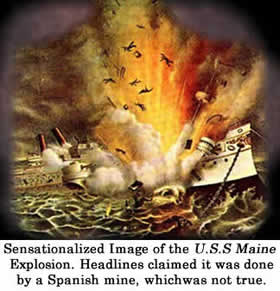 One week later the Maine, which had been sent “as a friendly act of courtesy” to protect American lives and property, blew up, killing over 200 American sailors. Of all those least likely to be responsible, Spain headed the list. Nevertheless, the yellow press adopted the slogan “Remember the Maine! To hell with Spain!” Much later it was determined that the explosion aboard the Maine was probably an accident, but the damage to international relationships had been done.
One week later the Maine, which had been sent “as a friendly act of courtesy” to protect American lives and property, blew up, killing over 200 American sailors. Of all those least likely to be responsible, Spain headed the list. Nevertheless, the yellow press adopted the slogan “Remember the Maine! To hell with Spain!” Much later it was determined that the explosion aboard the Maine was probably an accident, but the damage to international relationships had been done.
The Spanish ambassador was not the only one who thought President McKinley was wishy-washy. Although it is clear that he wanted Spain out of Cuba, even going so far as to offer to purchase the island, he was not hell-bent on going to war. Historians have generally concluded, however, that the American public, aroused by the yellow press, pushed the president into seeking a declaration of war. In his message to Congress, President McKinley offered various reasons for America’s contemplated actions, but added a curious note at the end:
Yesterday, and since the preparation of the foregoing message, official information was received by me that the latest decree of the Queen Regent of Spain directs General Blanco, in order to prepare and facilitate peace, to proclaim a suspension of hostilities, the duration and details of which have not yet been communicated to me.
This fact, with every other pertinent consideration, will, I am sure, have your just and careful attention in the solemn deliberations upon which you are about to enter. If this measure attains a successful result, then our aspirations as a Christian, peace-loving people will be realized. If it fails, it will be only another justification for our contemplated action.
On April 25, 1898, the U.S. declared that a state of war existed with Spain. An amendment known as the Teller Amendment was added to the declaration, indicating that the United States had no intention to annex Cuba.
The “Splendid Little War” (so called by future Secretary of State John Hay) was won handily by the United States over an inept Spanish army and navy. Americans supported the war enthusiastically, and many young men volunteered. However, the regular U.S. Army, which had done little but fight Indians since the Civil War, was ill prepared to manage the mobilization necessary to get on a war footing.
The Navy, on the other hand, was in good trim, having been expanded during the Harrison and Cleveland administrations in response to the writings of Mahan and the support of other “navalists” like Theodore Roosevelt. The Navy fought well from the beginning. Commodore Dewey, dispatched from Hong Kong, destroyed the Spanish fleet in Manila Bay in the Philippines, suffering only minor casualties to his ships and men. Later Admirals Sampson and Schley defeated the Spanish fleet off the coast of Cuba. The movement of naval vessels between Asia and the United States and around the tip of South America underscored the need for a canal between the Atlantic and Pacific Oceans in Central America. The naval war with Cuba also advanced the idea of overseas bases; both policies were later acted upon by President Roosevelt.
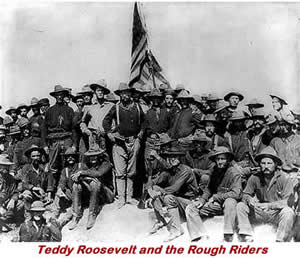 Although the Army was plagued by inefficiency, disease and disorder, American ground forces were bolstered by volunteers such as the famous “Rough Riders.” American soldiers fought bravely enough to defeat a hapless Spanish army near Santiago. American troops also occupied Puerto Rico. The fighting, which lasted less than four months, saw fewer than 400 American soldiers killed in combat. Over ten times as many died from disease, however. African American soldiers, many of them veterans of the Indian wars with the 9th and 10th Cavalry, played a vital role in the American victory, taking Kettle Hill alongside Roosevelt’s Rough Riders. The presence of black troops in camps and departure areas in the Southern states, however, caused several incidents in which the troops reacted against discriminatory policies. Roosevelt later praised the African American troops for their courage in the war.
Although the Army was plagued by inefficiency, disease and disorder, American ground forces were bolstered by volunteers such as the famous “Rough Riders.” American soldiers fought bravely enough to defeat a hapless Spanish army near Santiago. American troops also occupied Puerto Rico. The fighting, which lasted less than four months, saw fewer than 400 American soldiers killed in combat. Over ten times as many died from disease, however. African American soldiers, many of them veterans of the Indian wars with the 9th and 10th Cavalry, played a vital role in the American victory, taking Kettle Hill alongside Roosevelt’s Rough Riders. The presence of black troops in camps and departure areas in the Southern states, however, caused several incidents in which the troops reacted against discriminatory policies. Roosevelt later praised the African American troops for their courage in the war.
The Treaty of Paris of December 1898 ended the war and granted independence to Cuba. Spain turned over Puerto Rico, Guam, and the Philippine Islands to the United States, for which the U.S. paid Spain $20 million. Thanks to Dewey’s victory in Manila, American military forces occupied the Philippine Islands.
Philippine revolutionary Emilio Aguinaldo refused to exchange Spanish occupation for American and continued his insurrection against the new American “invaders.” The result was one of the ugliest wars in American history; the war and the annexation of the Philippine Islands created a large controversy over America’s role as an imperial power. Imperialists argued that the U.S. had a duty to help civilize and control the underdeveloped parts of the world. On the other hand, the Anti-Imperialist League, founded in 1899, opposed America’s acquisition of colonies as anti-democratic and destructive of American ideals. The result of the debate and the ugly Philippine insurrection was that the U.S. promised future independence to the Philippines and also eventually allowed Puerto Rico to determine its own destiny, a yet unfinished process. The Philippine Islands became independent in 1946.
The United States continued to occupy Cuba following the end of the war. Reforms were initiated in public administration, and public health agencies were brought under the direction of General Leonard Wood. American doctors Walter Reed and William Gorgas exterminated yellow fever in Cuba and pushed education and other reforms. A constitutional convention called in 1900 set up a Cuban government, and Americans withdrew in 1902.
As part of the legislation passed following the Spanish-American War the Platt Amendment of 1903 was added to a joint resolution of Congress outlining conditions under which U.S. troops would be withdrawn from Cuba. The amendment placed certain restrictions on Cuba, limiting her sovereignty to an extent:
- Cuba could make no treaties with other nations without U.S. agreement.
- Cuba could not create indebtedness beyond its means to pay.
- The U.S. reserved the right to intervene in Cuba to maintain law and order.
- The U.S. agreed to run a sanitation program.
- The U.S. was granted rights to a naval base at Guantanamo Bay until 1999. (The U.S. still operates a naval base at Guantanamo Bay.)
Hawaii
American interest in the Hawaiian Islands goes back to post-revolutionary days when American traders first started traversing the Pacific. Hawaii was a convenient stopping-off place for ships bound for China and Japan. American missionaries arrived in the islands in the early 19th century. The scenery, climate and valuable crops like sugar and fruits also attracted the attention of investors. In 1842 Secretary of State Daniel Webster recognized the importance of Hawaii for the United States. Native Hawaiians wanted to resist foreign intervention and saw the U.S as an ally in that effort. Although America made no move to annex or otherwise control Hawaii, American policy consistently sought to keep others from extending their influence over the islands.
In 1848, after the Southwestern territory, including California, was added to the United States as a result of the Mexican War, Hawaii became even more important. In 1849 the United States formally recognized Hawaiian independence, and although talk of annexation started, it came to nothing.
 In 1875 The U.S. signed a reciprocity trade treaty with Hawaii which admitted Hawaiian sugar to the U.S. duty free. Under the terms of the treaty, no Hawaiian territory was to be disposed of to a third party. The Reciprocity Treaty was renewed in 1884, and in 1887 rights to a fortified naval base at Pearl Harbor were added to the agreement. Later that year a revolution of white, mostly American, planters forced Hawaiian King Kalakaua to create a constitutional government, which soon became dominated by minority white Americans. By 1890 Americans controlled two-thirds of the land in Hawaii.
In 1875 The U.S. signed a reciprocity trade treaty with Hawaii which admitted Hawaiian sugar to the U.S. duty free. Under the terms of the treaty, no Hawaiian territory was to be disposed of to a third party. The Reciprocity Treaty was renewed in 1884, and in 1887 rights to a fortified naval base at Pearl Harbor were added to the agreement. Later that year a revolution of white, mostly American, planters forced Hawaiian King Kalakaua to create a constitutional government, which soon became dominated by minority white Americans. By 1890 Americans controlled two-thirds of the land in Hawaii.
The McKinley Tariff of 1890 ended the favorable sugar trade situation for Hawaii, resulting in large losses for American planters. Americans also lost power when Queen Liliuokalani, a strong Hawaiian nationalist, acceded to the throne in 1891 following the deaths of her brother, King Kalakaua. An educated woman, (she wrote “Aloha Oe”) she claimed that “Hawaii is for the Hawaiians!” and opposed political reforms. In 1893 a white citizens’ revolt led by Sanford Dole formed a “Committee of Safety” to overthrow the native government. American Minister to Hawaii John L. Stevens violated international law by improperly ordering U.S. Marines ashore from a warship, threatening the government. Dole became president of a new provisional government.
An annexation treaty was hastily sent to Washington and then submitted to the Senate by President Harrison, but Democrats in the Senate blocked it. When President Cleveland took office in March 1889, he withdrew the treaty and ordered an investigation. Cleveland sent former congressman James Blount to Hawaii. Blount reported wrongdoing against Queen Liliuokalani, and President Cleveland tried to have her restored to her throne. But the provisional government refused to step down and Cleveland was unwilling to use force in the matter. The U.S. Marines were withdrawn, however, and Cleveland refused to resubmit the treaty to the Senate. On July 4, 1894, the Republic of Hawaii was proclaimed and was recognized by the U.S.
Following the Spanish-American War, which had shined a new light on Hawaii because of activity in the Pacific—Hawaii was a vital link to the Far East—President McKinley negotiated a new annexation treaty, but it was blocked by anti-imperialists in the Senate, failing to get the necessary 2/3 vote. Congress then annexed Hawaii by a joint resolution of Congress, which required only a simple majority. President McKinley approved the resolution on July 7, and Hawaii became a U.S. territory on June 14, 1900.
With the addition of the Philippines, Guam, Puerto Rico, and Hawaii, America had at last gained an empire. Precipitated by sugar and pineapple growers anxious to maximize profits, the events in Hawaii were a clear case of economic imperialism backed up by government action. Not everyone in the nation was happy with America's new possessions. The Platform of the Anti-imperialist League of October 17, 1899, opened as follows:
We hold that the policy known as imperialism is hostile to liberty and tends toward militarism, an evil from which it has been our glory to be free. We regret that it has become necessary in the land of Washington and Lincoln to reaffirm that all men, of whatever race or color, are entitled to life, liberty, and the pursuit of happiness. We maintain that governments derive their just powers from the consent of the governed. We insist that the subjugation of any people is “criminal aggression” and open disloyalty to the distinctive principles of our Government.
The moral costs of creating an empire were not lost on many Americans.
Puerto Rico
The U.S. occupied Puerto Rico with a military force under the command of General Nelson Miles in 1898. The Foraker Act of 1900 attached Puerto Rico as unincorporated territory with an elective legislature, governor and council appointed by the President. In 1909 a split developed in Puerto Rico between an independence movement and supporters of U.S. statehood. The 1917 Jones Act declared Puerto Rico an “organized but unincorporated territory.” The Act gave Puerto Ricans U.S. citizenship. Modifications to the law also gave Puerto Ricans the right to elect their own governor in 1947. Puerto Rico was now “free” to write her own Constitution, the only restriction being that it not conflict with the U.S. Constitution. In 1952 the Commonwealth of Puerto Rico was established: statehood and independence options in lieu of the current territorial status are still available and under debate at the present time.
The Panama Canal
The Spanish-American War also renewed interest in the building of an isthmian canal, a project which the United States and other nations had been contemplating for half a century. In 1850 United States and Great Britain had signed the Clayton Bulwer Treaty, under which both nations agreed not to build a canal unilaterally. The first step in America's desire to pursue a canal was therefore to get the Clayton-Bulwer Treaty set aside. In 1901 Secretary of State Hay reached an agreement with British Ambassador Lord Julian Pauncefote to replace the Clayton-Bulwer agreement. Under the terms of the Hay-Pauncefote Treaty the U.S. was to permitted to construct and manage a Central American canal. In return, the United States was to guarantee the neutrality of the canal, open the canal and charge fair and equal rates for passage through the waterway to all nations.
An additional matter to be disposed of was the fact that the French De Lesseps company had begun digging a canal but had abandoned the project because of engineering problems. The company still had rights in Panama, however, and hoped to salvage something from the endeavor. The De Lesseps Company wanted $109 million for its rights, but the United States started investigating a possible route through Nicaragua. The French company dropped its price to $40 million when it saw that the U.S. House of Representatives might actually prefer the Nicaraguan route.
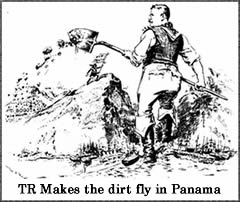 When Theodore Roosevelt took office in 1901, Panama was part of Colombia. Secretary of State John Hay negotiated a treaty with Tomas Herran of Columbia, calling for a payment of $10,000,000 and annual payments of $250,000. The Senate ratified the agreement But the Colombians, realizing that the U.S was willing to invest $40 million for the French rights, held out for more money and rejected the Hay-Herran Treaty. At about the same time, a group of Panamanian revolutionaries saw an opportunity and revolted against the Columbian government. President Roosevelt likewise saw the developments as promising, dispatched warships to the area as a show of support for the rebels, and then quickly recognized Panamanian independence.
When Theodore Roosevelt took office in 1901, Panama was part of Colombia. Secretary of State John Hay negotiated a treaty with Tomas Herran of Columbia, calling for a payment of $10,000,000 and annual payments of $250,000. The Senate ratified the agreement But the Colombians, realizing that the U.S was willing to invest $40 million for the French rights, held out for more money and rejected the Hay-Herran Treaty. At about the same time, a group of Panamanian revolutionaries saw an opportunity and revolted against the Columbian government. President Roosevelt likewise saw the developments as promising, dispatched warships to the area as a show of support for the rebels, and then quickly recognized Panamanian independence.
Negotiations quickly followed, and on February 23, 1904, the Hay-Buneau-Varilla Treaty was ratified. The agreement provided for a 10-mile-wide strip across Panama in return for a payment of $10 million and an annual fee of $250,000. Colombia lost $40 million but later received $25 million as partial compensation, which some called “guilt money.” There was much resentment among Latin American nations over TR’s “big stick” diplomacy. At home people call it “disgraceful” or “piracy.” In cabinet meeting Elihu Root said to TR, “You were accused of seduction but proved you were guilty of rape.” Roosevelt later said, “I took the Canal Zone, started the canal and let Congress debate me.” In his mind, the ends justified the means. TR wanted “to make the dirt fly” before the 1904 election.
The Panama Canal was completed in 1914 at cost of $400 million—one of the world's engineering wonders. The work was a major engineering triumph directed by Colonel George W. Goethals. The conquest of malaria and yellow fever by American doctors in the tropical jungle was an equally outstanding achievement of preventive medicine. The canal still operates with the original equipment.
President Roosevelt traveled to Panama to observe the work on the canal, but he also kept his eye on the rest of the world. He intervened in a crisis in Morocco, sponsoring a conference to settle differences between Germany and France. He persuaded Great Britain to attend the conference at Algeciras in Spain, which resulted in a peaceful settlement. United States ratified the resulting treaty but only to protect its own interests, not to interfere in Europe's affairs.
Over the next several decades, until Presidents Hoover and Franklin Roosevelt pursued a “good neighbor” policy, the United States continued to intervene in Latin America, sending in United States Marines or warships whenever trouble appeared on the horizon. The resentment among Latin American peoples about the behavior of the “Colossus of the North” never fully abated, though relations have improved since the time of unilateral American intervention in the business of its southern neighbors.
The United States and Asia
As a sign that American independence was a reality, in addition to being words on a paper treaty, in 1784 a merchant ship set out from Massachusetts bound for the Far East, appropriately named the Empress of China. During the following decades trade between the United States and China continued to grow. As the United States expanded westward to the Pacific Ocean, it was inevitable that American interests in Asia would move 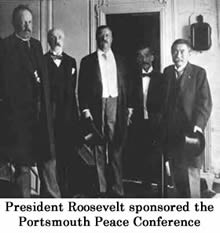 closer to the center of America's economic and diplomatic thinking. In the decades before the Civil War the United States reached a series of commercial agreements and treaties with China, and in 1852 Commodore Matthew C. Perry took four American steamships into Tokyo Harbor, the opening movement in developing relations between United States and Japan. A Japanese-American treaty was signed in 1854, formally advancing relations between the two countries. About that time Japan set out on a journey of modernization and, as some historians have put it, the Japanese advanced several hundred years in modernization within a few decades.
closer to the center of America's economic and diplomatic thinking. In the decades before the Civil War the United States reached a series of commercial agreements and treaties with China, and in 1852 Commodore Matthew C. Perry took four American steamships into Tokyo Harbor, the opening movement in developing relations between United States and Japan. A Japanese-American treaty was signed in 1854, formally advancing relations between the two countries. About that time Japan set out on a journey of modernization and, as some historians have put it, the Japanese advanced several hundred years in modernization within a few decades.
As the European nations continued to develop and expand their empires, tensions arose in the Far East, generated to some extent by Russian imperialism. War eventually broke out between Russia and Japan in 1904 over territorial issues involving Korea and Manchuria. In 1905 Japan startled the Western world by soundly defeating a supposedly superior Russian fleet in the battle of Tsushima Strait. The Russo-Japanese war was of concern to both Europe and America, and in an unprecedented move, President Theodore Roosevelt offered his mediation powers to bring an end to the conflict. Roosevelt's efforts led to the Treaty of Portsmouth, ending the war. For his efforts in ending the conflict, Roosevelt was awarded the Nobel peace prize for 1906, an honor he no doubt deserved.
Hay's Open Door. Following the Spanish-American War President McKinley sought to gain access to Chinese markets for all nations. In 1900 Secretary of State John Hay announced what became known as the "Open Door" policy with regard to China. His intention was that no European nation was to create a sphere of influence in China to the exclusion of other nations, and he sought agreement in that regard by circulating a diplomatic note among the major powers. His proposal would have put all nations on an equal footing in China. Although none of the powers formally agreed to the "Open Door," none refused, and Hay declared his policy a success. He believed that the Open Door policy would prevent other nations from partitioning China, thus excluding the United States.
In 1900 a group of Chinese nationalists attempted to end foreign occupation of their country by force, surrounding the embassies of the major powers in Peking. A relief expedition mounted by an eight-nation coalition eventually relieved the embassies, and the "Boxer Rebellion" was subdued. United States Marines, soldiers, and warships supported the international group in putting down the revolt. Thus America was once again willing to look outward and intervene overseas to further her own economic and political interests.
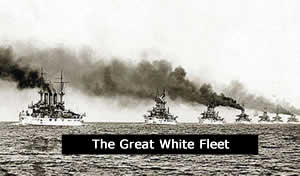 Asian workers continued to enter the United States, mostly through California, during the early 1900s, and anti-Japanese feelings began to emerge, as they had over the Chinese railroads workers who had settled in ghettos in western cities in the late 1800s. In 1906 tensions were raised when the San Francisco School Board created separate schools for Oriental children, which brought immediate protests from Asia. President Roosevelt arrived at a "Gentlemen's Agreement" with Japan under which the Japanese government would limit emigration to the United States.
Asian workers continued to enter the United States, mostly through California, during the early 1900s, and anti-Japanese feelings began to emerge, as they had over the Chinese railroads workers who had settled in ghettos in western cities in the late 1800s. In 1906 tensions were raised when the San Francisco School Board created separate schools for Oriental children, which brought immediate protests from Asia. President Roosevelt arrived at a "Gentlemen's Agreement" with Japan under which the Japanese government would limit emigration to the United States.
Subsequent treaties and agreements attempted to reassure Japan and China that the United States had no aggressive intentions toward either nation; but President Theodore Roosevelt sending the great white fleet on a world cruise which included Asia demonstrated that the United States was now a major naval power and had no fear of Japan. Complicated economic arrangements involving banking and other financial issues continued to strengthen ties between United States and China and Japan, but those complicated arrangements also created tensions that continued to build in the early 20th century. Later, as a result of Japan's participation on the side of the Allies in World War I, she was awarded control of the formerly German-held islands in the Pacific, which Japan later fortified. Those same islands had to be taken with much American blood during the Second World War.
In 1908 the Root-Takahira Agreement between the U.S. and Japan provided that both nations would respect each other's interests in the Pacific and observe the Open Door in China. Subsequent communications and agreements were an attempt to reassure Japan and China that the United States had no aggressive intentions toward either nation. In 1907, however, President Theodore Roosevelt dispatched the Great White Fleet on a world cruise, which included port visits in Asia, demonstrating that the United States was now a major naval power and was prepared to defend her interests in the Far East, including the Philippines. Japanese naval prowess shown at Tsushima would not be a deterrent to the United States. Critics worried about the possible repercussions, but when the fleet steamed into Tokyo Bay, the Americans were met by hundreds of Japanese children waving American flags and singing the "Star Spangled Banner" in English.
A Timeline of the Growth of Imperialism
|
| World Power Home | Imperial America | World War I | Updated January 28, 2018 |